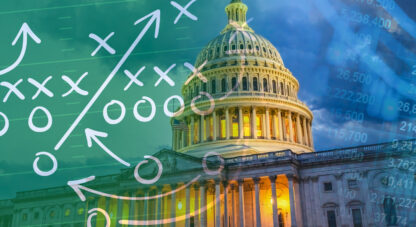Trading Places
This week in 1983, the hit film Trading Places was released in theaters. Forty years later, financial markets may be preparing for some trading places of their own as bulled-up markets, higher year-to-date and now excessively exuberant for the first time in more than a year, are at increased risk of reverting back to a resumption of the bear market in the months ahead. According to a Barron’s headline this week, “The stock market has climbed a wall of worry to start the year and is nearing a bull market. Now the fun part begins.”
Color HAI skeptical. When Barron’s starts selling tickets to the “fun part” of the party, the frivolity is usually getting set to wind down. We can probably paraphrase Churchill here in saying that this may not be the end. It may not even be the beginning of the end. But it is, perhaps, the end of the beginning of the market’s latest fixation with the “no-landing” narrative and the idea that the everything bubble is back on. This week’s headline could mark the latest in the long and storied history of the dreaded “Barron’s curse.”
Sentiment and technicals have gotten over-bullish and overcooked, the market is sucking in panic buyers chasing the move higher, inflation remains well above target, major central banks maintain a restrictive monetary policy stance, corporate earnings are falling, a credit crunch looms, and given the evolution of recent economic data we may be approaching peak soft-landing/no-landing narrative as the global economy sinks toward recession. This is a classic set-up for financial tempests and hard landings, not blue skies and bliss. In fact, just this week, the World Bank offered updated global growth projections forecasting a significant second half 2023 slowdown that will send global economic growth to low levels matching the 2008 great financial crisis. In the words of the World Bank’s chief economist, “the world economy is in a precarious position.”
This was a light week of economic news and data releases. After last week’s US ISM manufacturing PMI dropped further into contraction and the leading component of new orders dropped significantly, this week it was the ISM services release that disappointed. The services PMI dropped to 50.3, just a hair above contraction, but that was a solid drop from 51.9 the prior month and was way below expectations for an increase to 52.4. The 50.3 was the lowest reading since the very early Covid recovery in May of 2020. Importantly, just as on the manufacturing side, new orders, the most leading component, also experienced a big drop.
Fresh factory new order data was also released this week. The numbers dropped sufficiently to bring the six-month annualized data set to recessionary levels as well. We have seen weakness for a while in manufacturing and industrial production, but the key is that it’s worsening. Also, while the manufacturing and industrial economy is much smaller than the size of the services component of the economy, the manufacturing and industrial side is the cyclical part of the economy, and it leads services.
At the same time, momentum in the US labor market continues to slow, with the number of American workers applying for first-time unemployment benefits pushing back to their highest level since Oct. 2021. Initial jobless claims were notably weak, but this week claims jumped sharply by 28,000 to 261,000, which far exceeded expectations. The upward trend in initial claims data is undeniable. Since March, the trend has risen decisively higher than comparable periods in the past, at levels that are consistent with early recession periods.
Meanwhile on the credit crunch front, this week Raymond James managing director Randy Woodward said, “tighter credit, that’s the theme I want to keep pointing to. There are just so many things pointing to tighter credit.” As goes credit, so goes the economy, and right now it looks like this credit crunch doozy is set to arrive within three to six months. As HAI has pointed out previously, the credit crunch will exacerbate the already slowing economy. Ultimately, that slowdown will feed through to an accelerated weakening of the down trending labor market.
That “precarious position” for the world economy previously described by the World Bank is entirely reasonable and to be expected. A recent paper titled “Loose Monetary Policy and Financial Instability” by the Federal Reserve Bank of San Francisco offered the results of its empirical analysis based on 18 advanced economies from 1870 until 2020. The paper, not surprisingly (except when considering the source), found that “a loose [monetary policy] stance over an extended period of time leads to increased financial fragility several years down the line.” Crucially, the paper further concluded that, “historical evidence suggests that running such a high-pressure economy may not be sustainable in general… We argue that potential short-term gains come at considerable cost in the form of heightened risk of disasters in real economic activity.” HAI agrees with the conclusion, and we are coming off of the longest stretch of the loosest monetary policy in history. Such a reality entails consequence.
That said, right now the market couldn’t care less as the melt-up continues. After all, we’re in a “new era” in which old economic laws have been “suspended” and markets are partying like its early 1929. Nevertheless, history is unambiguously clear that financial excess is a harbinger of financial turmoil. The bigger the excess, the bigger the turmoil. Financial excess is inherently unsustainable. It is either withdrawn at the cost of great instability and pain, or it isn’t—at the cost of locking in a runaway inflationary trajectory towards terminal crack-up-boom dynamics. While HAI believes that the pandemic era “everything bubble” was a big step in the direction of a crack-up-boom phase, this author does not think markets are ready to crack up just yet.
That’s because Fed policy created the conditions that facilitated the bull market bubble-boom, but for now the Fed has meaningfully withdrawn those conditions. This key point is driven home in a recent comment by first ballot hall of fame investor Stanley Druckenmiller, “When I look back at the bull market that we’ve had in financial assets…all the factors that created that not only have stopped, they’ve reversed.” We don’t have zero interest rate policy. We don’t have outright quantitative easing. Rather, we have the return of the financial physics of interest rate gravity in the form of the highest interest rates in over a decade, while endless QE has morphed into $95 billion a month of QT. As long as the meaningfully more restrictive policy conditions remain, both the economy and markets will likely succumb to the “heightened risk of disasters in real economic activity” warned of by the SF Fed.
The market can speculate that the Fed will soon pivot back to easy policy. The market can front-run the Fed, as it is now doing. However, in doing these things, the market rally keeps inflation elevated for longer and the Fed restrictive for longer. At the same time, as markets rally and the economy slips closer to recession, the tether that binds markets to the economy gets stretched to dangerous extremes that risk a violent snap-back.
Again, the conditions supporting the bubble have substantially reversed, but as of yet, make no mistake, the bubble remains. Consider that if October were the major bear market low for this cycle, it would be, by an order of magnitude, the most expensive bear market bottom in stock market history. The market cap-to-GDP of the Wilshire 5000 total US market index (the famed Buffet indicator) troughed in October at a 1.43x multiple, and has since rebounded to 1.57x. That’s utterly remarkable when considering that such a “trough” valuation multiple is still higher than the absolute peak of the 2000 tech bubble which, before the everything bubble, itself represented the highest multiple extreme in history by an order of magnitude.
Unless we are already at the point of full Federal Reserve policy capitulation to high inflation as policy, where the transition from gold standard to Fed standard to no standard is complete, 2023’s stock market rally isn’t an all-clear signal that a new multi-year bull-market has begun. Instead, it’s very likely a doomed second attempt bear-market-echo bubble, a bull-trap, and little more than a dangerous opportunity for return-free-risk.
If the October low was the bottom, however, and the current rally is the start of a new bull market despite the myriad factors conspiring against such an outcome, it would certainly be a striking indication that the early stages of terminal crack-up-boom dynamics may have begun. Given the circumstances, next week’s Federal reserve FOMC policy meeting couldn’t be more fascinating.
Meanwhile there are still pockets of value in this market. As Bank of America chief investment strategist Michael Hartnett highlighted this week, the differing pricing extremes in this market are dramatic. Some sectors are “already priced for hard landing,” while others are “priced for no landing.” Certainly, at present, this extreme bi-polar pricing is most obviously on display in the contrast between commodity markets that are priced for recession and a tech sector pricing in only blue skies and bliss. As JPMorgan strategists correctly pointed out this week, the S&P 500 and equity markets more broadly are “priced for perfection.” By contrast, the value of a broad basket of commodities relative to the S&P 500 currently remains near 50-year lows. Despite historically bullish tight supply side fundamentals as far as the eye can see, and an incredibly positive demand outlook on the other side of recession, the current ratio of commodities to the S&P is multiples lower than its 50-year median. Commodities are now a store of deep value, and, under almost any scenario, HAI expects the depressed relative value of commodities to mean revert higher in explosive fashion over the upcoming decade.
While the commodity outlook is very bright, gold’s future may be even more alluring. In an interesting and unusually candid reveal for a central bank, the Central Bank of Hungary detailed its rationale for buying the yellow metal in a recent press release. The bank said that it added gold as a “risk mitigator” for expected “disruption during a period of transition in the international monetary system.” Again, an interesting central bank validation that there is an ongoing “transition in the international monetary system.”
Singing the same tune in its latest report, The Singapore Bullion Market Association suggested that recent heavy central bank gold demand has been catalyzed by an accelerated push to diversify their reserve asset base. While the SBMA acknowledged that the dollar’s position as global reserve currency and the position of US Treasurys as the top global reserve asset will remain “for many years to come,” the organization stressed, nevertheless, that the dollar’s “position will face a steady erosion that may be accelerated due to the weaponization of the dollar in recent years.”
Former Credit Suisse analyst Zoltan Pozsar, who previously worked at the US Treasury and the Federal Reserve Bank of New York, commented on the topic of a “transition in the international monetary system” in a recent interview. Pozsar said that, in this transition, “I think gold is going to have a very special meaning… Gold is coming back on the margin as a reserve asset and as a settlement medium for interstate capital flows.” Pozsar also said that in this era of widespread uncertainty, when he talks to some of the most sophisticated hedge funds and investors globally, the common refrain he hears is that “they’ve never seen an environment as complicated as this.” Amid that highly uncertain and complicated environment, he notes, “there is consensus around gold; it’s a safe bet.”
Pozsar went on to say “everything else is very uncertain. This is a very unique environment. I think we need to take a very, very broad perspective to actively reimagine and rethink our understanding of the world, because things are changing fast.” HAI agrees on both the world changing fast and on the bright future of gold—for a seemingly endless list of reasons. To be clear, the topic of a transition in the international monetary system is a slow burn issue. For now and the foreseeable future, the transition is only a marginal one. So marginal, in fact, as to likely not have a material impact on the current dollar system for a long time. That said, in HAI’s view, if gold holdings increase as a share of total global reserve assets, the price positive impact for gold is likely to be significant, and that impact has likely already started. From “barbarous relic” back to competitive global reserve asset status, gold is poised for some long-awaited Trading Places as well.
Weekly performance: The S&P 500 was up 0.39%. Gold gained 0.39%, silver added 2.78%, platinum gained 0.93%, while palladium was clubbed by 7.03%. The HUI gold miners index lost 1.14%. The IFRA iShares US Infrastructure ETF was up 1.68%. Energy commodities were volatile and mixed on the week. WTI crude oil lost 2.19%, while natural gas gained 3.78%. The CRB Commodity Index was up 0.32%, and copper gained 1.58%. The Dow Jones US Specialty Real Estate Investment Trust Index was nearly flat, up 0.15% on the week, and the Vanguard Utilities ETF was up 1.85%. The dollar was down 0.40% to close at 103.53. The yield on the 10-yr Treasury was higher by 6 bps, ending the week at 3.75%
Best Regards,
Morgan Lewis
Investment Strategist & Co-Portfolio Manager
MWM LLC















